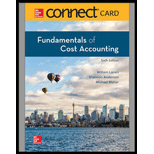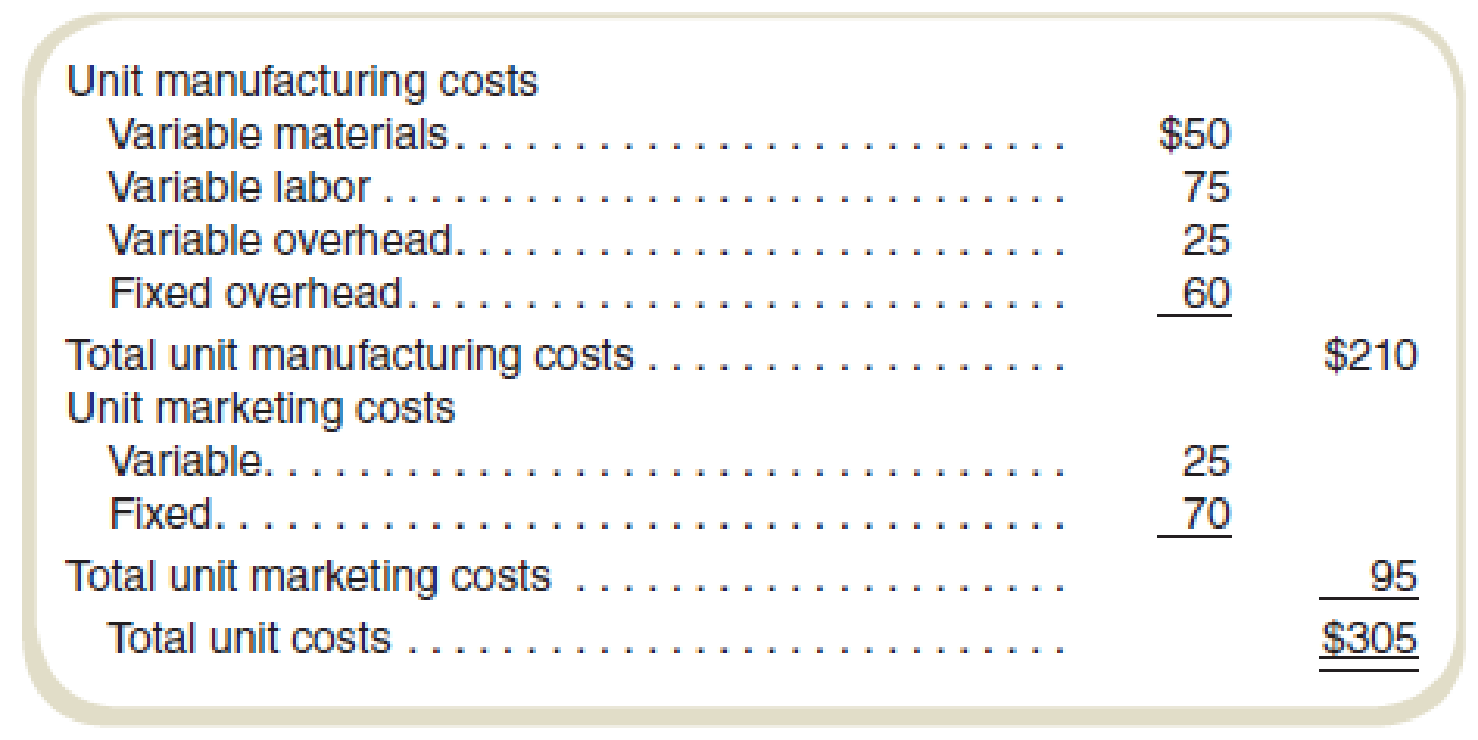
Davis Kitchen Supply produces stoves for commercial kitchens. The costs to manufacture and market the stoves at the company’s normal volume of 6,000 units per month are shown in the following table:

Unless otherwise stated, assume that no connection exists between the situation described in each question; each is independent. Unless otherwise stated, assume a regular selling price of $370 per unit. Ignore income taxes and other costs that are not mentioned in the table or in the question itself.
Required
- a.
Market research estimates that volume could be increased to 7,000 units, which is well within production capacity limitations if the price were cut from $370 to $325 per unit. Assuming that the cost behavior patterns implied by the data in the table are correct, would you recommend taking this action? What would be the impact on monthly sales, costs, and income? - b. On March 1, the federal government offers Davis a contract to supply 1,000 units to military bases for a March 31 delivery. Because of an unusually large number of rush orders from its regular customers, Davis plans to produce 8,000 units during March, which will use all available capacity. If it accepts the government order, it would lose 1,000 units normally sold to regular customers to a competitor. The government contract would reimburse its “share of March
manufacturing costs ” plus pay a $50,000 fixed fee (profit). (No variable marketing costs would be incurred on the government’s units.) What impact would accepting the government contract have on March income? (Part of your problem is to figure out the meaning of “share of March manufacturing costs.”) - c. Davis has an opportunity to enter a highly competitive foreign market. An attraction of the foreign market is that its demand is greatest when the domestic market’s demand is quite low; thus, idle production facilities could be used without affecting domestic business. An order for 2,000 units is being sought at a below-normal price to enter this market. For this order, shipping costs will total $40 per unit; total (marketing) costs to obtain the contract will be $4,000. No other variable marketing costs would be required on this order, and it would not affect domestic business. What is the minimum unit price that Davis should consider for this order of 2,000 units?
- d. An inventory of 460 units of an obsolete model of the stove remains in the stockroom. These must be sold through regular channels (thus incurring variable marketing costs) at reduced prices or the inventory will soon be valueless. What is the minimum acceptable selling price for these units?
- e. A proposal is received from an outside contractor who will make and ship 2,000 stoves per month directly to Davis’s customers as orders are received from Davis’s sales force. Davis’s fixed marketing costs would be unaffected, but its variable marketing costs would be cut by 20 percent for these 2,000 units produced by the contractor. Davis’s plant would operate at two-thirds of its normal level, and total fixed manufacturing costs would be cut by 30 percent. What in-house unit cost should be used to compare with the quotation received from the supplier? Should the proposal be accepted for a price (that is, payment to the outside contractor) of $215 per unit?
- f. Assume the same facts as in requirement (e) except that the idle facilities would be used to produce 1,600 modified stoves per month for use in extreme climates. These modified stoves could be sold for $450 each, while the costs of production would be $275 per unit variable manufacturing expense. Variable marketing costs would be $50 per unit. Fixed marketing and manufacturing costs would be unchanged whether the original 6,000 regular stoves were manufactured or the mix of 4,000 regular stoves plus 1,600 modified stoves were produced. Should the proposal be accepted for a price of $215 per unit to the outside contractor?
a.
Explain whether the action should be taken or not on the basis of the given situation. Also, identify the impact on monthly sales, costs, and income.
Explanation of Solution
Differential cost:
The cost difference of two alternatives is differential cost. Before taking any decision, the management of the business has to check for various options to make sure the reliability of the alternative.
| Particulars | Before Price Reduction | After price reduction | Impact | Increase/decrease |
| Sales price | $370 | $325 | ||
| Quantity | 6000 | 7000 | ||
| Revenue | $2,220,000 | $2,275,000 | $55,000 | Increase |
| Variable manufacturing cost | $900,000 | $1,050,000 | $150,000 | Increase |
| Variable marketing costs | $150,000 | $175,000 | $25,000 | Increase |
| Contribution margin | $1,170,000 | $1,050,000 | ($120,000) | Decrease |
| Fixed manufacturing costs | $360,000 | $360,000 | ||
| Fixed marketing costs | $420,000 | $420,000 | ||
| Income | $390,000 | $270,000 | ($120,000) | Decrease |
Table: (1)
Thus, the price should not be lowered because it results in a decrease in operating profit. However, the market share and other points can be taken into consideration.
b.
Identify the impact of the increase in price on profit.
Explanation of Solution
The impact of the increase in price on profit:
| Particulars | Without Government Contract | With Government Contract | Impact | Increase/decrease | ||
| Regular | Government | Total | ||||
| Revenue | $2,960,000 | $2,590,000 | $245,000 (1) | $2,835,000 | ($125,000) | Decrease |
| Variable manufacturing costs | $1,200,000 | $1,050,000 | $150,000 | $1,200,000 | $0 | |
| Variable marketing costs | $200,000 | $175,000 | $0 | $175,000 | ($25,000) | Decrease |
| Contribution margin | $1,560,000 | $1,365,000 | $95,000 | $1,460,000 | ($100,000) | Decrease |
| Fixed manufacturing costs | $360,000 | $360,000 | $0 | |||
| Fixed marketing costs | $420,000 | $420,000 | $0 | |||
| Income | $780,000 | $680,000 | ($100,000) | Decrease | ||
Table: (2)
Thus, the contact should not be accepted because it results in decrease in income to the company.
Working note 1:
Compute the government revenue:
c.
Find the minimum unit price that Mr. D should consider for this order of 2,000 units.
Explanation of Solution
Compute the minimum unit price that Mr. D should consider for this order of 2,000 units:
Thus, the minimum unit price that Mr. D should consider for this order of 2,000 units is $192.
d.
Determine the minimum acceptable selling price for the given units.
Explanation of Solution
Determine the minimum acceptable selling price for the given units:
The minimum acceptable selling price will be the differential costs which involve the marketing costs of $25 per unit. The minimum price is the differential marketing costs because the variable costs must be recovered for selling the product. The additional price if charged will add to the income.
e.
Calculate the in-house unit cost which should be used to compare with the quotation received from the supplier. Also, decide whether the proposal should be accepted for a price of $215 per unit.
Explanation of Solution
Calculate the in-house unit cost which should be used to compare with the quotation received from the supplier:
| Particulars | All Production In-house | 2,000 Units Contracted |
| Total revenue | $ 2,220,000 | $ 2,220,000 |
| Total variable manufacturing costs | $ 900,000 | $ 1,030,000 (2) |
| Total variable marketing costs | $ 150,000 | $ 140,000 (3) |
| Total contribution margin | $ 1,170,000 | $ 1,050,000 |
| Total fixed manufacturing costs | $ 360,000 | $ 252,000 (4) |
| Total fixed marketing costs | $ 420,000 | $ 420,000 |
| Income | $ 390,000 | $ 378,000 |
Table: (3)
The proposed price of $215 should not be accepted by the management because it would result in a decrease in net income by $12,000. Thus, price of $215 is not an acceptable price.
Working note 2:
Compute the total variable manufacturing costs when 2,000 units are being contracted:
Working note 3:
Compute the total variable marketing costs when 2,000 units are being contracted:
Working note 4:
Compute the total fixed marketing costs when 2,000 units are being contracted:
f.
Determine whether the proposal should be accepted for a price of $215 per unit to the outside contractor.
Explanation of Solution
Determine the income for a price of $215 per unit to the outside contractor:
| Particulars | 6,000 Regular Stoves Produced | Contract 2,000 Regular stoves; Produce 1,600 Modified stoves and 4,000 Regular Stoves | |||
| In-house | Regular (In) | Regular (Out) | Modified | Total | |
| Revenue | $2,220,000 | $1,480,000 | $740,000 | $720,000 | $2,940,000 (5) |
| Variable manufacturing costs | $900,000 | $600,000 | $430,000 | $440,000 | $1,470,000 (6) |
| Variable marketing costs | $150,000 | $100,000 | $40,000 | $80,000 | $220,000 (7) |
| Contribution margin | $1,170,000 | $780,000 | $270,000 | $200,000 | $1,250,000 |
| Fixed manufacturing costs | $360,000 | $360,000 | |||
| Fixed marketing costs | $420,000 | $420,000 | |||
| Income | $390,000 | $470,000 | |||
Table: (4)
Compute the in-house cost savings from the contract:
| Particulars | Amount (per unit) |
| Variable manufacturing cost saved | $ 150 |
| Variable marketing saved | $ 5 |
| Contribution from freed-up capacity | $ 100 |
| In-house cost savings | $ 255 |
Table: (5)
The proposed price of $215 should be accepted now. The deal made with the subcontractor is more profitable as there is a cost saving of $255 per unit.
Working note 5:
Compute the total revenue when 2,000 units are being contracted:
Working note 6:
Compute the total variable manufacturing costs when 2,000 units are being contracted:
Working note 7:
Compute the total variable marketing costs when 2,000 units are being contracted:
Want to see more full solutions like this?
Chapter 4 Solutions
Connect Access Card For Fundamentals Of Cost Accounting

 AccountingAccountingISBN:9781337272094Author:WARREN, Carl S., Reeve, James M., Duchac, Jonathan E.Publisher:Cengage Learning,
AccountingAccountingISBN:9781337272094Author:WARREN, Carl S., Reeve, James M., Duchac, Jonathan E.Publisher:Cengage Learning, Accounting Information SystemsAccountingISBN:9781337619202Author:Hall, James A.Publisher:Cengage Learning,
Accounting Information SystemsAccountingISBN:9781337619202Author:Hall, James A.Publisher:Cengage Learning, Horngren's Cost Accounting: A Managerial Emphasis...AccountingISBN:9780134475585Author:Srikant M. Datar, Madhav V. RajanPublisher:PEARSON
Horngren's Cost Accounting: A Managerial Emphasis...AccountingISBN:9780134475585Author:Srikant M. Datar, Madhav V. RajanPublisher:PEARSON Intermediate AccountingAccountingISBN:9781259722660Author:J. David Spiceland, Mark W. Nelson, Wayne M ThomasPublisher:McGraw-Hill Education
Intermediate AccountingAccountingISBN:9781259722660Author:J. David Spiceland, Mark W. Nelson, Wayne M ThomasPublisher:McGraw-Hill Education Financial and Managerial AccountingAccountingISBN:9781259726705Author:John J Wild, Ken W. Shaw, Barbara Chiappetta Fundamental Accounting PrinciplesPublisher:McGraw-Hill Education
Financial and Managerial AccountingAccountingISBN:9781259726705Author:John J Wild, Ken W. Shaw, Barbara Chiappetta Fundamental Accounting PrinciplesPublisher:McGraw-Hill Education





